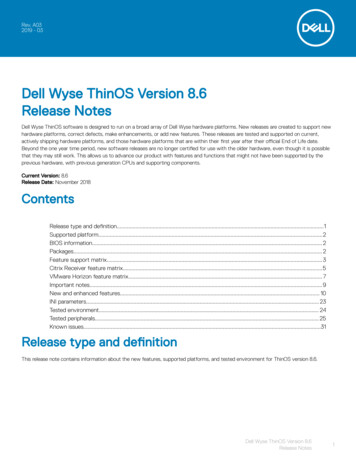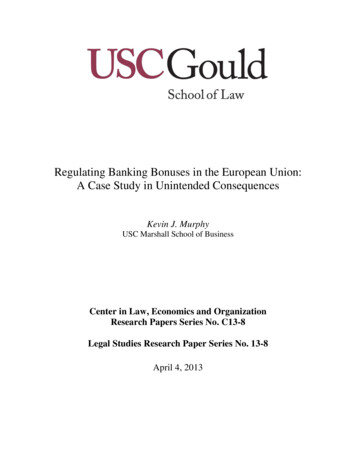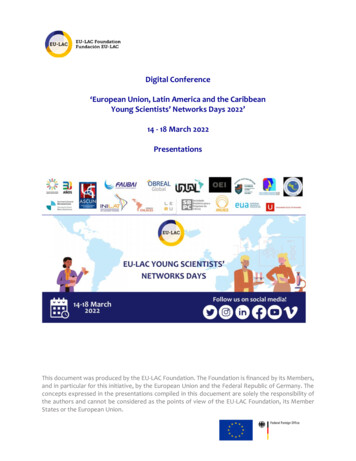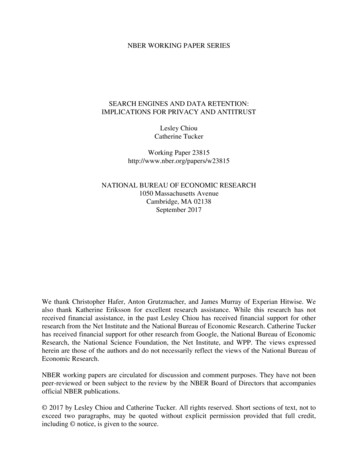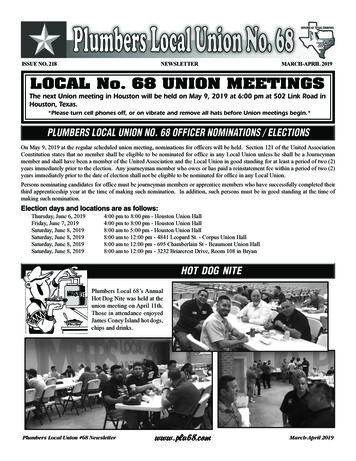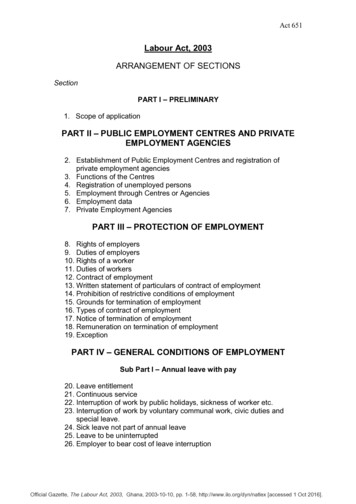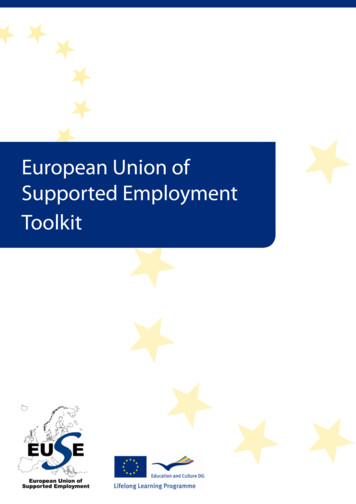
Transcription
European Union ofSupported EmploymentToolkit
ContentsPAGEIntroduction3Participating Organisations5Committee and Meetings6Key Partnership Participants7EUSE Position PapersValues, Standards and Principles of Supported Employment9Client Engagement13Paid and Unpaid Work12Vocational Profile17Work Experience Placements23Job Finding27Working with Employers31On and Off the Job Support35Career Development & Progression40Supported Employment for Key Policy Makers44Supported Employment for Employers50How To GuidesClient Engagement54Vocational Profile62Job Finding79On and Off the Job Support92Qualities of a Good Employment Support Worker104Glossary1132
IntroductionThe European Union of Supported Employment was established to develop SupportedEmployment throughout Europe. Studies and research have shown that there is a lack ofconsistency, guidance and training materials for professionals and service providersemployed in the field of Supported Employment for disabled/disadvantaged people.The European Union of Supported Employment developed a Partnership consisting ofmanagers and professionals who represent national, regional and local SupportedEmployment service providers across Europe. The partners were already linked throughtheir involvement with the European Union of Supported Employment and all thepartners are currently delivering some form of vocational training or Supported Employment service either through their role as a local or regional organisation or through theirnational organisation for Supported Employment.The Partnership’s aim was to produce a European Supported Employment Toolkit. Thistoolkit consists of a range of Position Papers and How to Guides and has been designed toincrease the knowledge and skills of professionals responsible for the delivery of SupportedEmployment services. The toolkit is primarily aimed at service providers for use in theirstaff development programmes.The objectives of the Partnership were to: Design and develop a range of learning, practical guidance and instructional materialsthat will support service providers/participants in the acquisition and use of knowledge,skills and awareness to support disabled/disadvantaged people into the Europeanlabour market Develop the Supported Employment model in Europe to facilitate improvements tostandards and practices in the vocational education and training of Supported Employment service provider organisations Improve the quality and increase the cooperation between organisations, institutionsand professionals involved in the delivery of Supported Employment services throughoutEurope Facilitate the development of innovative and good practices in the field of SupportedEmployment/Vocational Education and Training between the participating countries/partners3
European Union of Supported Employment ToolkitIntroductionThe Partnership sought to reinforce a consistent methodology for the delivery of specialistSupported Employment services for people with significant disabilities as part of a longerterm aim of increasing the numbers of severely disabled people entering sustainableemployment. The Partnership sought to address the need for support and assistancerequired by employers and to meet the need for improved awareness by policy makers andfunders.It is widely recognised that people with disabilities are one of the most economicallyinactive groups who face significant barriers when trying to access the open labour market.It was the intention of this Partnership to increase the awareness and competencies of thestaff that are responsible for the assessment, job finding and on-going employment supportfor job seekers and employees with disabilities. Moreover, the Toolkit aims to reinforce thevalues, standards, principles and process of Supported Employment and to encourage us allto adhere to the full model of Supported Employment.Michael J EvansPresident, European Union of Supported EmploymentManager, Employment Unit, Dundee City Council4
Participating OrganisationsAustriaLead Partner:Dachverband berufliche Integration AustriaDenmarkLead Partner:Associated Partners:Slagelse KommuneVASAC SlagelseVASAC OdsherredEllehøjEUSE DenmarkEnglandLead Partner:British Association of Supported EmploymentFinlandLead Partner:Associated Partners:VATES FoundationRehabilitation FoundationKiipula Centre of Vocational Education and RehabilitationGermanyLead Partner:Bundesarbeitsgemeinschaft für UnterstützteBeschäftigung e.V.GreeceLead Partner:Associate Partner:Theotokos FoundationHellenic Association of Supported EmploymentIrelandLead Partner:Associate Partner:Irish Association of Supported Employment LtdEmployment Response North West LimitedNorthern IrelandLead Partner:Northern Ireland Union of Supported EmploymentNorwayLead Partner:Associate Partner:Mølla KompetansesenterForum for Arbeid med BistandScotlandLead Partner:Associate Partner:Dundee City CouncilScottish Union of Supported EmploymentSpainLead Partner:Asociación Española de Empleo con ApoyoSwedenLead Partner:Associate Partner:Stiftelsen Activa I Örebro länSvenska Föreningen för Supported Employment5
Committee and MeetingsPartnership CoordinatorMike EvansDundee City Council, ScotlandPartnership Meeting VenuesNovember 2008March 2009August 2009November 2009January 2010March 2010June 2010Vienna, AustriaPalma, SpainStockholm, SwedenAthens, GreeceLondon, EnglandDublin, IrelandCopenhagen, DenmarkEditorial CommitteeMike EvansMarlene MayrhoferHenning JahnScotlandAustriaDenmark6
Key Partnership ParticipantsAARNSETH, KikkiNorwayBELLVER, FernandoSpain*BENGTSSON, Johanne LouiseDenmarkBOYD, NeilScotland*CUNNINGHAM, DermotIreland*DAVIES, HuwEngland*DOOSE, StefanGermany*DUNLOP, EdythN Ireland*EKLUND, BengtSweden*ELSTON, RobertEngland*EVANS, MikeScotlandFRAGNER, UteAustriaHAARA, ØyvindNorway*HADDOCK, MargaretN IrelandHARKAPAA, KristiinaFinlandHATLEM, CathincaNorwayHAUGAARD, MarieDenmarkJAHN, HenningDenmark*HOHN, KirstenGermanyJENSEN, Stig BahlDenmarkJOHANSSON, BertilSwedenKATSOUDA, KaitiGreeceLAMPINEN, PauliinaFinlandMARTINEZ, SalvadorSpain*MAYRHOFER, MarleneAustriaORA, PetteriFinlandPIKKUSAARI, SuviFinland*RYAN, DavidIrelandVEITLMEIER, SabineAustria*WANGEN, GreteNorwayWIIG, IngunnNorwayZAPHIROPOULOU, IoGreece* Denotes Lead Officer for a Position Paper/How To Guide7
The Position Papers are designed to provide essential andrelevant information for not only Supported Employmentservice providers but also for disabled people, parents/carers, employers and policy makers at local, national andinternational levels.The Position Papers state the views of the European Unionof Supported Employment on a wide range of SupportedEmployment topics and encourage us all to adhere to thestrengths and values of the complete Supported Employmentmodel.8
European Union of Supported Employment Position PaperValues, Standards and Principlesof Supported EmploymentIntroductionSupported Employment is a method of working with disabled people and other disadvantagedgroups to access and maintain paid employment in the open labour market. This method ofworking is a proactive policy in accordance with the United Nations Convention on the Rightsof People with Disabilities.This paper will define the differences with this methodology and other support mechanismscurrently being used around Europe and will provide the position of the European Union ofSupported Employment regarding the values, standards and process of Supported Employment.BackgroundThe concept, principles and values of Supported Employment are based on the early workfrom North America which demonstrated that people with significant learning disabilitiescould perform a variety of complex tasks, highlighting the potential and capabilities ofpeople with learning disabilities to participate in paid work in the open labour market. Dueto the success of Supported Employment assisting people with learning disabilities to accessand maintain employment, the model was developed and expanded to include all areas ofdisability and disadvantage.In the late 1980’s, the model transferred across the Atlantic to Europe and a number ofdisability organisations in various European countries successfully piloted SupportedEmployment projects funded mainly under European Union programmes such as Helios andHorizon.The European Union of Supported Employment (EUSE) was formed in 1993 and hasdeveloped its structure since that time. The definition of Supported Employment in Europeis recognised as:“Providing support to people with disabilities or other disadvantaged groups tosecure and maintain paid employment in the open labour market”European Union of Supported Employment 2005.9
European Union of Supported Employment Position PaperValues, Standards and Principlesof Supported EmploymentThe IssuesSupported Employment is completely consistent with the concepts of empowerment, socialinclusion, dignity and respect for individuals. Within Europe, agreement has been reachedon the values and principles that should be present at all Supported Employment stagesand activities and adhere to full citizenship rights of individuals1 :Individuality – Supported Employment regards each individual as unique, with his / her owninterests, preferences, conditions and life historyRespect – Supported Employment activities are always age appropriate, dignifying andenhancingSelf-determination – Supported Employment assists individuals to improve their interestsand preferences, express their choices and define their employment / life plan according topersonal and contextual conditions. It promotes the principles of self-advocacy by serviceusersInformed Choice – Supported Employment assists individuals to understand their opportunitiesfully so they can choose consistently within their preferences and with an understanding ofthe consequences of their choicesEmpowerment – Supported Employment assists individuals to make decisions on theirlifestyle and participation in society. Individuals are centrally involved in the planning,evaluation and development of servicesConfidentiality – The Supported Employment service provider considers information givenby individuals to them as confidential. The service user has access to his/her personalinformation gathered by the provider and any disclosure is at the discretion of and withthe agreement of the individualFlexibility – Staff and organisational structures are able to change according to the needsof service users. Services are flexible and responsive to the needs of individuals and can beadapted to meet specific requirementsAccessibility – Supported Employment services, facilities and information are fully accessibleto all people with disabilities.1European Union of Supported Employment – Information Booklet and Quality Standards (2005)10
European Union of Supported Employment Position PaperValues, Standards and Principlesof Supported EmploymentThe values and principles of Supported Employment are supported by a 5-stage process/methodology that has been identified and acknowledged as a European model of goodpractice which can be used as the framework within Supported Employment2.Engagement – Underpinned by the core values of accessibility to ensure informed choicesare madeVocational Profiling – Ensuring empowerment to the individual throughout the processJob Finding – Self-determination and informed choice are key values in Supported EmploymentEmployer Engagement – Accessibility, flexibility and confidentiality are key values to benurtured through this processOn/Off Job Support – Flexibility, confidentiality and respect are the key components tosuccessful support measures. Support measures particularly refer to when the individual isin paid employment and are delivered through the provision of an Employment SupportWorker/Job CoachPosition of the European Union of Supported EmploymentThe European Union of Supported Employment promotes the concept of SupportedEmployment as a vehicle/methodology to assist disabled and disadvantaged peopleaccess their right to work.Whilst there are slight variations of the definition across the world, there remain threeconsistent elements that are fundamental to the European Supported Employmentmodel:1. Paid Work - Individuals should receive commensurate pay for work carried out – if acountry operates a national minimum wage then the individual must be paid at leastthis rate or the going rate for the job2. Open Labour Market – People with disabilities should be regular employees with thesame wages, terms and conditions as other employees who are employed in businesses/organisations within the public, private or voluntary sectors3. Ongoing Support - This refers to job support in its widest concept whilst in paidemployment. Support is individualised and is on a needs basis for both the employeeand the employer2European Union of Supported Employment – Information Booklet and Quality Standards (2005)11
European Union of Supported Employment Position PaperValues, Standards and Principlesof Supported EmploymentThe European Union of Supported Employment promotes that professionals working inthe area of Supported Employment should be able to demonstrate professional competence,knowledge and awareness of the values underpinning the process of SupportedEmployment.ConclusionSupported Employment is a method of intervention which assists individuals with disability ordisadvantage to access paid jobs in the open labour market. The European Union of SupportedEmployment has clearly stated values and principles with ethical guidelines for professionalsto ensure that the needs of the individual are paramount regarding all decisions in relationto the Supported Employment process.Further Reading EUSE Position PaperEUSE Position PaperEUSE Position PaperEUSE Position PaperEUSE Position Paper“Client Engagement”“Vocational Profiling”“Job Finding”“Working with Employers”“On and Off Job Support”12Designed by Dundee City Council, 2009
European Union of Supported Employment Position PaperClient EngagementIntroductionLike many models of employment intervention, Supported Employment values the initialclient engagement process. This process is essential to ensure understanding by all parties(i.e. the job seeker and the Supported Employment organisation) before progressing onto the next stage of the Supported Employment model.This paper provides the position of the European Union of Supported Employment withregards to the issues and Supported Employment activities within the stage of ClientEngagement.BackgroundClient Engagement is the first key stage of the 5 stage Supported Employment process1 .It is essential that the core principles of respect, self-determination, informed choice,empowerment, confidentiality, flexibility, accessibility and individuality are embedded inthis initial stage2 .The outcome of client engagement is to ensure that the individual makes an informedchoice as to whether they wish to use the Supported Employment model to find a job andwhich Supported Employment organisation can assist them to achieve employment.Activities during this stage are wide and varied and require to be designed to ensure theindividual is equipped with the correct information and knowledge before making aninformed decision to move onto a Supported Employment programme. Activities mustalso be relevant and person centred if a positive outcome is to be achieved.Moreover, the value base of zero rejection is embedded in the Supported Employmentmodel under the ethos of “anyone who wishes to work can work, provided the correctlevel of support is available”.For more information on the 5 stage Supported Employment process see EUSE (2005): European Union of SupportedEmployment – Information Booklet and Quality Standards12For further details see also EUSE Position Paper „Values, Standards and Principles of Supported Employment“13
European Union of Supported Employment Position PaperClient EngagementIssuesThe principle of zero rejection remains a contentious issue across Europe. Many mainstreamlocal and national Government funded programmes are called “Supported Employment”and meet the individual country’s criteria or understanding of economic employment ratherthan the value base of Supported Employment as described above. This can result in jobseekers requiring to meet certain criteria to be eligible to access the project; for example, ajob seeker may have to agree to work a minimum number of hours. This rejects and placesrestrictions on many potential job seekers with complex needs. The model of SupportedEmployment was originally developed to assist people with significant disabilities toaccess and maintain paid employment. This must always be at the forefront of anySupported Employment development.The issue of “job readiness” is another factor that many countries impose in currentgovernment mainstream programmes; this again is against the principle of SupportedEmployment of placing the individual in the job – training them on the job – andmaintaining and progressing them. The terminology of job readiness has resulted in manydisabled people engaging in training to become job ready for most or all of their lives.Professionals working in the field have to signpost individuals seeking work to otheralternative programmes of training and/or education when in fact it is work they areseeking. This once again goes against the fundamental principles of Supported Employment.These programmes by their restraints of “economic employment” terminology oftenpreclude those most in need of the model of Supported Employment. However, it isimportant to maintain the values and principles of the model and organisations shouldstrive to achieve this.Due to the above constraints which many Supported Employment professionals workwithin, key areas of partnership working have been developed and; communication toestablish an understanding of Supported Employment within Europe continues.Apart from these two fundamental issues (zero rejection and job readiness) the main aim ofClient Engagement stage is to ensure the individual is well informed of the SupportedEmployment process and to identify a suitable support organisation.Supported Employment organisations, when engaging with an individual, shouldensure that the information they provide is clear, accurate, easily understood and availablein accessible formats (such as large print, Braille, audio, plain language etc). Supported14
European Union of Supported Employment Position PaperClient EngagementEmployment organisations need to explore alternative methods of engaging with peoplewith disabilities and people from other disadvantaged groups. It is not sufficient to onlyproduce information on services (such as information leaflets) but they also need to followthis up with face to face meetings, meetings with other stakeholders which have beensuggested by the individual (such as a family member, health professional, teacher, careersadviser etc) and using new technology. Client engagement should also be held over aperiod of time.However, there are often restrictions on the length of time an Employment Support Workercan spend on this stage of the process. Supported Employment organisations need to investtime and energy within the Client Engagement stage which will benefit future stages of theSupported Employment process.A Person centred approach should be adopted by the Supported Employment organisationto achieve this. This approach will ensure that the individual is involved and in control of theClient Engagement stage and that they are making informed choices and decisions.Individuals, in deciding which Supported Employment organisation to use, should have achoice of a number of providers. However, in certain geographical areas and in particularrural areas, there may be only one provider which the individual can use. Even if this is thecase, the Supported Employment organisation should ensure good practice by adopting aperson centred approach and ensuring that information and communication is provided isaccessible.Position of the European Union of Supported EmploymentWhilst recognising and welcoming the mainstreaming (Government funded programmes)of Supported Employment across countries in Europe, EUSE has concerns that thereis not a unified European approach to the delivery of the model. The European Union ofSupported Employment maintains that the model of Supported Employment has the fivestages of Engagement, Vocational Profiling, Job Finding, Employer Engagement and On/Off Job Support. Programmes which do not have all of these components or indeed haveadditional components are not Supported Employment. The naming therefore of manyprogrammes as Supported Employment leads to confusion for all key stakeholders fromGovernment agencies to people with disabilities.EUSE will strive to ensure that the core values of Supported Employment are maintained.Engagement is the first stage of an important process for an individual and as such shouldlead to employment.EUSE recommends a person centred approach to be adopted throughout the 5 Stage15
European Union of Supported Employment Position PaperClient EngagementSupported Employment model and that it is particularly important during the ClientEngagement stage. Furthermore, Supported Employment organisations need to ensurethat information and methods of communication are fully accessible and appropriate for allindividuals.EUSE advocates that individuals should have a choice of Supported Employment organisationsto select, however they do recognise that this is not always possible or viable in certainareas. EUSE would recommend that all Supported Employment organisations regardless ifthey are the only providers should strive towards best practice.ConclusionThe European Union of Supported Employment believes that there are difficulties withinthe current “models” of Supported Employment across Europe and as a result will continueto engage and inform key policy makers of the “model”. Whilst taking this view EUSE alsorecognises the need for economic employment to be core to many country’s employmentaction plans. The area for debate and exploration for the foreseeable future lies with EUSEworking across Europe to ensure that we balance the need for both economic employmentand the rights of the individuals wishing to work, who can work with the correct support.Further Reading EUSE Position Paper “Values, Standards and Principles of Supported Employment”16
European Union of Supported Employment Position PaperPaid & Unpaid WorkIntroductionThe right for employees to receive payment for employment is valued as a fundamentalprinciple within the European model of Supported Employment.This paper provides the position of the European Union of Supported Employmentregarding issues related to paid and unpaid employment within Supported Employmentin Europe.BackgroundThe European Union of Supported Employment was formed in 1993 and has an agreeddefinition of Supported Employment which states that:“Providing support to people with disabilities or other disadvantaged groups to secureand maintain paid employment in the open labour market”European Union of Supported Employment 2005Whilst there are slight variations of the definition across the world, there is a generalagreement that clients of Supported Employment should be paid the going rate for thejob. Despite the universal acknowledgement of paid employment as a fundamentalprinciple, there remain concerns that clients of Supported Employment are not alwaysreceiving either the going rate for the job, the national minimum wage (where one exists)or any wages at all.The IssuesThe issues which have arisen around paid and unpaid work stem from the claims by arange of organisations across Europe who state that they are delivering Supported Employmentbut, because of the lack of a wage payment, may not be fulfilling a basic element of theEuropean Supported Employment model (paid employment in the open labour market).17
European Union of Supported Employment Position PaperPaid & Unpaid WorkTo clarify this, it is important to state what Supported Employment is generally agreed notto be: Work Experience – payment is not received for work carried out Voluntary Work – payment is not received for work carried out Vocational Training – this is not workWhilst acknowledging that work experience placements and voluntary work are not inthemselves Supported Employment, it is important to note that they may be acceptablemethodologies to assist people into employment as a relevant vehicle to build experience,knowledge and the confidence of the individual in a work environment.Both are also possible ways for employers to get to know future employees and thereforepotentially increase their willingness to employ1.There is a danger however, that if individuals progress to work experience or voluntarywork (i.e. unpaid jobs) they may be seen as ‘working’ and can be left in that situationwithout progressing to paid employment. There is evidence that some providers ofSupported Employment are not developing job seekers into paid jobs although this maybe for valid reasons such as funding, benefit loss or the individual’s inability to cope withtasks in a paid capacity.Position of the European Union of Supported EmploymentThe model of Supported Employment revolves around support interventions for individualswhen they are in paid work. By paid work we mean that: Individuals should receive commensurate pay for work carried out – if a country operatesa national minimum wage this is the least that should be paid. Terms and conditions ofemployment (i.e. annual leave, pension schemes, and expenses) should be the same asother employeesThe European Union of Supported Employment recognises the need and the value of arange of interventions in supporting individuals with disability and disadvantage intoemployment. However, paid employment is the recognised right of every individual andthis is a fundamental aspect of the European Supported Employment model that should beadopted as the ultimate goal by all Supported Employment service providers.Unpaid work such as job tasters, work experience placements and voluntary work are inthemselves not Supported Employment. However, it is recognised that they can be used1For further details see also EUSE Position Paper “Work experience placements”.18
European Union of Supported Employment Position PaperPaid & Unpaid Workas a progression activity towards securing paid work in the open labour market. Theseactivities should also be strictly time-limited and should only be organised when there is agenuine need and is an agreed requirement of the individual job seeker.ConclusionThe European Union of Supported Employment unequivocally supports paid work as theright of every person who seeks employment within the Supported Employment model.The European Union of Supported Employment recognises other “unpaid” work optionsas being used in an individual’s journeys to paid work but believes that they should be ofa temporary nature and serve a specific purpose to improve the skills of the individualensuring progress and access to paid work.Further reading: EUSE Position Paper “Work experience placements” EUSE Position Paper “Values, standards and principles” EUSE Position Paper “Working with employers”19
European Union of Supported Employment Position PaperVocational ProfileIntroductionIn order to assist people with disabilities or disadvantage to secure and maintain paidemployment, a person-centered approach is used within Supported Employment to collectrelevant information about the individual’s aspirations, interests and abilities for work.In the Supported Employment process a vocational profile is used to gather this information.This paper provides the position of the European Union of Supported Employment on theaspects of vocational profiling within Supported Employment.BackgroundSupported Employment was developed in the 1970/80’s to assist people with disabilities tomake their own choices about work and to define what support they need in order to beable to work. Vocational profiling was therefore established as a person centred tool to assistjob seekers make informed choices about job preferences and to establish the necessarytraining strategies for on or off the job support. This differed from the traditional assessmentprocess within rehabilitation programmes where individuals were tested in shelteredsurroundings and were presented with different support alternatives by rehabilitationspecialists.In the vocational profiling process today, job seekers are supported to make informed andrealistic choices about work and future career development.The IssuesThe vocational profile occurs at the second stage of the 5-stage Supported Employmentprocess1 . It is a tool that provides a structured and goal orientated approach towardssecuring and maintaining employment in the open labour market within a person centredapproach. The objective is to achieve the best possible match between the job seekers’ skillsand support needs and the requirements of the job/employer; this is called the job match.For a description of the 5 stages see also EUSE (2005): European Union for Supported Employment – InformationBooklet and Quality Standards120
European Union of Supported Employment Position PaperVocational ProfileVocational profiling in Supported Employment is not about service providers collectinginformation about the job seeker and then making decisions on their behalf. Vocationalprofiling is a tool that service providers may use to facilitate the process so that the jobseeker is able to make personal and informed choices about jobs and careers.Vocational profiling aims to develop the persons’ own awareness and understanding ofopportunities and obstacles in the labour market. There is evidence that vocationalprofiling is one of the most important success factors for susta
Values, Standards and Principles of Supported Employment 9 Client Engagement 13 Paid and Unpaid Work 12 Vocational Profile 17 Work Experience Placements 23 Job Finding 27 Working with Employers 31 On and Off the Job Support 35 Career Development & Progression 40 Supported Employment for Key Policy Makers 44 Supported Employment for Employers 50 How To Guides Client Engagement 54 Vocational .
